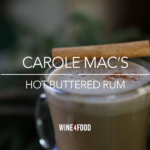Rosengarten Classic. Originally Published: Wine Enthusiast, July 2009.
SPECIAL 2012 NOTE: I’m into something fantastic right now: the best rum cakes I’ve ever tasted. I mean it. And everyone who tastes them says the same. AND…you can taste them yourself!…by ordering them from me in time for the holidays. Great gifts. Great feasts!
After the archive piece below, you will find complete descriptions of these cakes, mouthwatering photos, and full ordering details. Before we go there, however…I wanted to give you a little rum background in the form of a column I wrote for The Wine Enthusiast a few years back. Enjoy the rum talk…then enjoy the rum cakes!
This column is not going to be an extensive, in-depth analysis of Caribbean rum. No way. That’s because I’m in the middle right now of an intensive research session, and you know how that can be.
On the other hand, through darkness…light! The more I, ahem, research, the more it becomes clear to me exactly what it is that the normal consumer needs to know in order to have his or her Caribbean rum game together.
So listen carefully. Here are the crown jewels of Caribbean rum knowledge, albeit simplified:
1) It helps to know what this stuff is. You know it’s made from sugar cane, but sugar cane has a bewildering number of products and by-products. Simple explanation: In the 1600s, the sugar industry in the Caribbean, thanks to the new arrival of slaves from Africa, was cranking up its production and about to stumble on a big discovery. To make refined sugar—then and now—you have to squeeze sugar cane juice out of the sugar cane, boil it, process it, and, if you go all the way, white refined sugar is produced for eager consumers around the world. A necessary by-product is the sticky-dark molasses, which initially didn’t have a purpose other than being a by-product. Purpose arrived in the 17th century, probably in Barbados southeast Caribbean, in the form of the notion that you could ferment molasses, then distill the fermented liquid, ending up with a clear, high-alcohol spirit…called rum!
2) Soon, all of the Caribbean islands where sugar cane was growing got into the rum game, making rum from molasses. But each island made, and makes, its own style of rum—which made, and makes, things confusing for the consumer.
3) Here’s my epiphany (which I’m sure has been epiphed a million times before): your best guide to what’s what is knowing the national background of each island’s colonizers…Spanish, English or French (the three of whom bashed it out for centuries trying to establish control).
4) On the Spanish islands, a taste developed for clear, light rum–which is still the specialty of these places (think about see-through Bacardi, and you’ve got the idea). These are rums for mixing light-rum drinks, such as dacquiris and, most important, mojitos.
5) On the English islands, things went another way. Possibly with their national taste for English-owned classics like Port, like dark Sherry, the Brits encouraged the transformation of rum into something darker, richer. Not all dark rums are from English islands, of course…but it was the English who encouraged the storage of clear rum in wood barrels (which added color and richness), and the addition of caramel for even darker color. A rum like Myers’ Original Dark, from English-influenced Jamaica, is textbook—except that it ain’t great (it’s right in front of me and all I can smell or taste is alcohol). Dark English-style rums can be sipped (if they’re excellent), or turned into dark-rum cocktails (like Jamaica’s famous Dark ‘n Stormy, which combines dark rum and ginger beer).
6) On the French islands…oh, those French. “What if way dun make zee rum from zee mo-lass-SEZ…but…razzair…make eet from zee sugar cane juice itself?” they asked. And so they did. And so they came up with something unmistakably different, really quite French. In places like Martinique, the rum, made from sugar cane juice, not molasses, is called “rhum agricole”—and dang if it doesn’t have a more earthy character to it, a greater sense of, well, terroir, a greater complexity and elegance. The more direct connection of that sugar cane juice to the sugar cane itself makes the difference. Despite no molasses, it is dark rum, or, more correctly, amber (barrels and caramel do the trick)…but think of French Cognac and Armagnac as next of kin…the classic iron fists in velvet gloves. Good examples of French-island rum are the perfect, thoughtful, post-prandial sippers.
(2012 NOTE: The special case of Venezuela! Since I wrote this piece, I have fallen in love with the rums of a South American Country that touches the Caribbean: Venezuela. They are into age here, using solera systems to produce complex rums that suggest everything from butterscotch to nuts to spices, usually in a medium-bodied style.)
So…next time you’re buying rum…simply give yourself the Rum Style Quiz: do I want light, mixing rum…or dark English-style rum for dark cocktails…or cerebral, artisanal French rum for sipping? Once you know, find your country–and set sail for your rum shop!
Spanish-Influenced Rum Countries:
Cuba
Puerto Rico
Dominican Republic
English-Influenced Rum Countries:
Bahamas
British West Indies (Cayman Islands, Turks and Caicos)
Jamaica
British Virgin Islands (Tortola, Virgin Gorda, etc.)
Dominica
Saint Lucia (with some French history)
Anguilla
Antigua
Barbuda
St Kitts
Nevis
Montserrat
Barbados
St. Vincent
Grenada
Trinidad
Tobago
French-Influenced Rum Countries:
Haiti
French West Indies (Guadeloupe, Saint-Martin on the French side, Saint Bart, Les Saintes, Marie-Galante, Desirade, Martinique)
SPECIAL 2012 FOLLOW-UP: ACQUIRING RUM CAKE
Und now…ze cakes!
I first tasted Craig Adcock’s simply amazing Kansas City Rum Cake about five years ago. Just as a journalist, and a food enthusiast, I’ve been touting it ever since. Telling all my friends. Buying and sharing whenever possible. It was even the dessert I served to the press at my re-launch ROSENGARTEN REPORT party a few years back. I so stand behind this product!
But now…things have gotten even better. I asked Craig last year (busy man though he is) if he would consider baking two more cakes—each one with a different rum, so that my readers might receive a sampler pack of THREE rum cakes, made with THREE different rums!
He said yes, bless him.
And here we are. Holiday season 2012—and your ability to buy what may be the THREE most delicious cakes you’ve ever tasted. To order, simply visit my shop HERE. Be sure to use discount code TASTE20 for 20% off of your order.
I’ve been dazzling my friends with rum cake tastings (everyone seems to have a different preference!)…and finishing holiday meals in grand fashion…and sending gifts of rum cake to all the feinschmeckers on my list!
Here are the three varieties that Craig has whipped up for me:
1 – “Jude’s Original”
Jude’s Original Kansas City Rum Cake
Soft, mellow, cake made from rum distilled in the revived Ninth Ward of New Orleans. This is our baseline rum cake, for those who prefer a comforting blend of all elements. A modicum of crispy pecans on top.
Light Nuts
Jude’s Rum Cake made with Old New Orleans Rum 3 year
(from the Lower 9th Ward)
2 – “Barbancourt Crunch”
Made with fiery, top-grade Barbancourt rum from Haiti. The exhilarating, full-blast rum experience…matched and balanced perfectly by a plethora of crispy pecans.
Heavy Nuts
Barbancourt 5 star (8 year)
3 – “St. Teresa Anejo”
Elegant Santa Teresa Anejo Gran Reserva Rum Cake
Made from the greatest Venezuelan rum. Eggy, buttery, browned-tasting, with no nuts (to give the subtlety center stage)…but with a thin veneer of caramelized sugar on top. The choice for connoisseurs.
Nut-free
Santa Teresa Anejo Gran Reserva
HAPPY HOLIDAYS!






